Multi-Wave Liquid Crystal Variable Retarders / Wave Plates
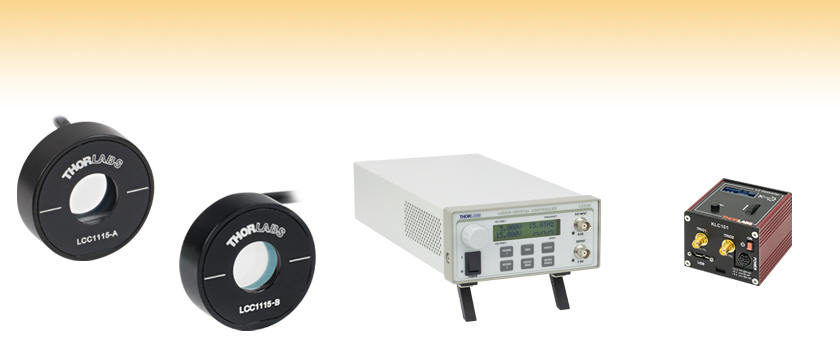
- Nematic Liquid Crystal Multi-Wave Variable Retarders
- Available with >6λ Max Retardation
- AR Coated for Visible, NIR, or IR Light
- Ø10 mm Clear Aperture
LCC1115-A
Ø10 mm Clear Aperture,
>6λ Variable Retarder
ARC: 350 - 700 nm
LCC1115-B
Ø10 mm Clear Aperture,
>6λ Variable Retarder
ARC: 650 - 1050 nm
LCC25
Benchtop LC Controller
KLC101
K-Cube™ LC Controller

Please Wait
Operating Principle
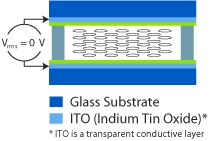
High Retardance
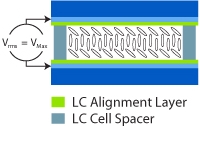
Low Retardance
In their nematic phase, liquid crystal molecules have an ordered orientation, which together with the stretched shape of the molecules creates an optical anisotropy. When an electric field is applied, the molecules align to the field and the level of birefringence is controlled by the tilting of the LC molecules.
| Selection Guide for LC Retarders | |
|---|---|
| Type | Clear Aperture |
| Half Wave | Ø10 mm or Ø20 mm |
| Half Wave, Thermally Stabilized | Ø10 mm |
| Full Wave | Ø10 mm or Ø20 mm |
| Full Wave, Thermally Stabilized | Ø20 mm |
| Multi-Wave | Ø10 mm |
| Multi-Wave, Integrated Controller | Ø10 mm |
| Custom LC Retarders | |
Features
- Variable Wave Plate to Continuously Control the Polarization State of Light
- Retardance Range
- LCC1115-A: ~60 nm to >6λ
- LCC1115-B and LCC1115-C: ~400 nm to >6λ
- Clear Aperture: Ø10 mm
- Three Antireflection Coatings Available
- LCC1115-A: 350 - 700 nm
- LCC1115-B: 650 - 1050 nm
- LCC1115-C: 1050 - 1700 nm
- Surface Quality: 40-20 Scratch-Dig
- Retardance Uniformity: <λ/50 Over the Entire Clear Aperture
Thorlabs' Multi-Wave Liquid Crystal Variable Retarders (LCVR) use nematic liquid crystal cells to function as variable wave plates. The absence of moving parts provides quick switching times on the order of milliseconds (see the Switching Time tab for details). Our multi-wave retarders are AR coated for 350 - 700 nm, 650 - 1050 nm, or 1050 - 1700 nm and can reach up to >6λ retardance (see the Performance tab for transmission and retardance data). An LC cell spacer that is 30 µm thick in the LCC1115-A or 50 µm thick in the LCC1115-B and LCC1115-C aids each retarder in achieving its maximum retardance value. The retarders have Ø10 mm clear apertures with a 1" outer diameters, making them compatible with any of our Ø1" optics mounts for 8 mm thick optics. An engraved white line on the front of each housing marks the slow axis.
Performance
These liquid crystal variable retarders provide excellent uniformity, low optical losses, and low wavefront distortion. They also provide quick switching times, a broad operating temperature range, and a broad wavelength range. Please see the Specs, Performance, and Switching Time tabs for complete details.
Operation
A Liquid Crystal Variable Retarder consists of a transparent cell filled with a solution of Liquid Crystal (LC) molecules and functions as a variable wave plate. The orientation of the LC molecules is determined by the alignment layer in the absence of an applied voltage. The alignment layer is composed of an organic polyimide (PI) coating whose molecules are aligned in the rubbing direction during manufacturing. Due to the birefringence of the LC material, this LC retarder acts as an optically anisotropic wave plate, with its slow axis, marked on the mechanical housing, parallel to the surface of the retarder. Two parallel inner faces of the cell wall are coated with a transparent conductive film so that a voltage can be applied across the cell. When an AC voltage is applied, the LC molecules will reorient from their default alignment according to the applied Vrms.
Controllers
The LCC25 and KLC101 liquid crystal controllers provide active DC offset compensation while applying an AC voltage (0 to 25 Vrms). The DC offset compensation automatically zeros the DC bias across the LC device in order to counteract the buildup of charge.
| Item # | LCC1115-A | LCC1115-B | LCC1115-C |
|---|---|---|---|
| Wavelength Range | 350 - 700 nma | 650 - 1050 nm | 1050 - 1700 nm |
| Liquid Crystal Material | Nematic Liquid Crystal | ||
| Retardance Range | ~60 nm to >6λ | ~400 nm to >6λ | |
| Clear Aperture | Ø10 mm | ||
| Surface Quality | 40-20 Scratch-Dig | ||
| Beam Deviation | <5 arcmin | ||
| Switching Time (Rise / Fall, Typical)b | 423 ms / 70 ms (1 λ to 2 λ) |
820 ms / 190 ms (1 λ to 3 λ) |
720 ms / 187.5 ms (1 λ to 2 λ) |
| AR Coating | Ravg < 0.5% at all Air-to-Glass Surfaces for Specified Wavelength Range | ||
| Wavefront Distortion | ≤λ/4 (@ 635 nm) | ||
| Retardance Uniformity | <λ/50 Over the Entire Clear Aperture | ||
| Housing Outer Diameter | 1" | ||
| Storage Temperature | -30 to 70 °C | ||
| Operation Temperature | -20 to 45 °C | ||
| Compatible Mounts | RSP1 (RSP1/M), CRM1T (CRM1T/M), CRM1PT (CRM1PT/M), KM100 | ||
LC Retarder Performance
In their nematic phase, liquid crystals molecules have an ordered orientation, which together with the stretched shape of the molecules, creates an optical anisotropy. When an electric field is applied, the molecules align to the field and the level of effective retardance is controlled by the tilting of the LC molecules. To minimize effects due to ions in the material, an LC device must be driven using an alternating voltage. Our LCC25 and KLC101 controllers, sold below, are designed to minimize the DC bias in the driving signal in the operating range of 0 V to 25 V.
Due to changes in the molecular polarizability, the LC material exhibits higher chromatic dispersion at short wavelengths and comparably small chromatic dispersion at long wavelengths. To account for this, we provide the retardance data at one or two select wavelengths within the product's wavelength range in the table to the right.
Additionally, the LC retardation also depends on the temperature of the device. As temperature increases, the retardation decreases with it. However, as seen in the Switching Time tab, the switching time of the LC improves at higher temperatures. Generally, the LC's refractive indices (both ordinary and extraordinary) change more drastically as temperature nears the LC's clearing temperature. As such, we choose to use materials with a high clearing temperature to minimize the temperature dependence when used at room temperature.
Click Here to Download Retardance Data
Click Here to Download Transmission Data
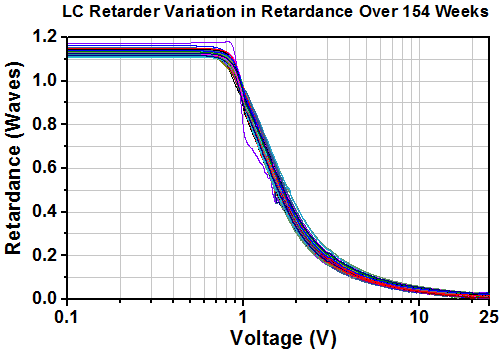
Click to Enlarge
Graph shows variation in retardance over a period of 154 weeks.
Long-Term Stability
Our liquid crystal retarders exhibit consistent performance over time. The graph to the right shows the retardance vs. voltage for one previous-generation LCC1112-A three-quarter wave retarder, driven by our LCC25 liquid crystal controller over 154 weeks. The retardance was tested once per week and varied only slightly over the testing period. For the complete set of data from testing each week, please click below to download the full data file.
The graph below to the left shows that the retardance varies only slightly at a constant voltage, while the graph below to the right shows that the voltage varies only slightly at a constant retardance. Similar consistency in performance can also be expected for our other models of retarders. To maximize the long-term stability of our retarders, we recommend always using our LCC25 or KLC101 controllers. They are designed to reduce the DC voltage offset, thus minimizing charge buildup and maximizing stability.
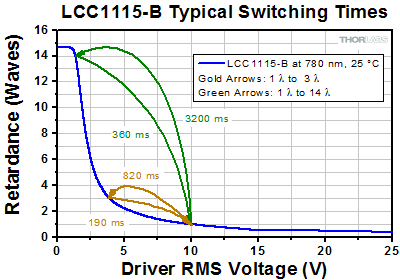
Click to Enlarge
Switching Time Decreases with Smaller Retardance Changes
LC Retarders Switching Time
Liquid crystal retarders feature a short switching time compared to mechanical variable wave plates due to the lack of moving parts. The switching time of a liquid crystal retarder depends on several variables, some of which are controlled in the manufacturing process, and some by the user.
In general liquid crystal retarders will always switch faster when changing from a high to a low birefringence value. Additionally, the higher the operating temperature is, the faster the retarder will switch from one state to another due to the decreased viscosity at the higher temperature.
For any given retarder, the switching time will always be faster at higher voltages. The graph to the right depicts examples of switching between different voltages. If trying to achieve faster switching times, we recommend using the retarder together with a fixed waveplate, to use the variable retarder at a higher voltage.
In addition, the material's viscosity and hence the switching time also depends on temperature of the LC material. As can be seen below, the switching time can increase by as much as two times by heating the LC retarder. Our standard LC retarders are designed to work at temperatures of up to 45 °C, where they can still maintain the specified retardation. If faster switching times are required, the retarders can work at temperatures up to 70 °C, but the maximum retardation value will be lower.
The switching time is also directly proportional to the thickness of the LC retarder, the rotational viscosity of the LC material, and the dielectric anisotropy of the LC material. However, since each of those variables affects other operating parameters as well, our LC retarders are designed to optimize overall performance, with a special emphasis on switching time. We also offer OEM and custom LC retarders optimized for other parameters, as well as faster liquid crystal retarders. Contact techsupport@thorlabs.com for details.
Sample Switching Times at Various Temperatures
Switching times were tested by measuring the rise time from V1 to V2 and the fall time from V2 to V1 with the liquid crystal retarder being held at the specified temperature. V1 was fixed in all of the tests and corresponds to the control voltage when the LC retarder is at 1 λ retardation. V2 is the voltage at the target retardation value. Please note that switching times at lower voltages (for instance, if V1=5 V) are longer than the switching times specified below.
LCC1115-A
| Temperature | V1 | V2 | Rise Time (ms) | Fall Time (ms) |
|---|---|---|---|---|
| From 1 λ to 2 λ | ||||
| 25 °C | 3.1 | 1.92 | 423 | 70 |
| 45.1 °C | 3.1 | 1.92 | 150 | 20 |
| 59.9 °C | 3.1 | 1.92 | 140 | 20 |
| 70.2 °C | 3.1 | 1.92 | 100 | 20 |
| From 1 λ to 4 λ | ||||
| 25 °C | 3.1 | 1.34 | 1580 | 100 |
| 45.1 °C | 3.1 | 1.34 | 480 | 50 |
| 59.9 °C | 3.1 | 1.34 | 340 | 30 |
| 70.2 °C | 3.1 | 1.34 | 260 | 27 |
| From 1 λ to 8 λ | ||||
| 25 °C | 3.1 | 1.04 | 1953 | 140 |
| 45.1 °C | 3.1 | 1.04 | 940 | 58 |
| 59.9 °C | 3.1 | 1.04 | 630 | 40 |
| 70.2 °C | 3.1 | 1.04 | 435 | 35 |
LCC1115-B
| Temperature | V1 | V2 | Rise Time (ms) | Fall Time (ms) |
|---|---|---|---|---|
| From 1 λ to 3 λ | ||||
| 25 °C | 10 | 3.82 | 820 | 190 |
| 45.1 °C | 10 | 3.82 | 350 | 110 |
| 59.9 °C | 10 | 3.82 | 280 | 110 |
| 70.2 °C | 10 | 3.82 | 145 | 60 |
| From 1 λ to 7 λ | ||||
| 25 °C | 10 | 2.3 | 1020 | 235 |
| 45.1 °C | 10 | 2.3 | 740 | 140 |
| 59.9 °C | 10 | 2.3 | 637.5 | 100 |
| 70.2 °C | 10 | 2.3 | 537.5 | 80 |
| From 1 λ to 14 λ | ||||
| 25 °C | 10 | 1.34 | 3200 | 360 |
| 45.1 °C | 10 | 1.34 | 2530 | 180 |
| 59.9 °C | 10 | 1.34 | 2100 | 120 |
| 70.2 °C | 10 | 1.34 | 1460 | 100 |
LCC1115-C
| Temperature | V1 | V2 | Rise Time (ms) | Fall Time (ms) |
|---|---|---|---|---|
| From 1 λ to 2 λ | ||||
| 25 °C | 4.94 | 2.96 | 720 | 187.5 |
| 45.1 °C | 4.94 | 2.96 | 282.5 | 86.5 |
| 59.9 °C | 4.94 | 2.96 | 192.5 | 75 |
| 70.2 °C | 4.94 | 2.96 | 97.5 | 62.5 |
| From 1 λ to 4 λ | ||||
| 25 °C | 4.94 | 1.98 | 2850 | 230 |
| 45.1 °C | 4.94 | 1.98 | 1405 | 135 |
| 59.9 °C | 4.94 | 1.98 | 722.5 | 100 |
| 70.2 °C | 4.94 | 1.98 | 477.5 | 99.5 |
| From 1 λ to 6 λ | ||||
| 25 °C | 1.36 | 1.185 | 4700 | 390 |
| 45.1 °C | 1.36 | 1.185 | 1835 | 200 |
| 59.9 °C | 1.36 | 1.185 | 1185 | 130 |
| 70.2 °C | 1.36 | 1.185 | 1550 | 105 |
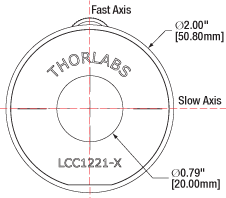
Drawing indicates the slow and fast axes
Alignment
The slow (extraordinary) axis of the liquid crystal retarder corresponds to the orientation of the long axis of the liquid crystal molecules when no voltage is being applied. Applying a voltage will cause the orientation direction of the liquid crystal molecules to rotate out of the plane of the drawing to the right, changing the retardation. Thorlabs LC retarders are nematic liquid crystal devices, which must be driven with an AC voltage in order to prevent the accumulation of ions and free charges, which degrades performance and can cause the device to burn out.
In order to precisely align the axis of the liquid crystal cell, mount the retarder in an appropriate rotation mount (e.g. the RSP1(/M) or the CRM1PT(/M) for our Ø10 mm clear aperture retarders and RSP2(/M) or LCRM2A(/M) for our Ø20 mm clear aperture retarders). Then set up a detector or power meter to monitor the transmission of a beam through a pair of crossed linear polarizers. Next place the LC retarder between two crossed polarizers with the slow axis aligned with the transmission axis of the first polarizer. Then slowly rotate it until the transmitted intensity is minimized. In this configuration, the LC retarder is ready for phase modulation applications.
To operate as a light intensity modulator or shutter, again find the minimum transmitted intensity as prescribed above. Once the minimum is found, rotate the retarder by ±45°. This will maximize the transmitted intensity through the crossed polarizers for most LC retarders (e.g., zero-order quarter- or half-wave plates). However, this rule of thumb does not rigidly hold for multi-wave phase retarders using broadband sources due to the wavelength dependency of the retardation.
Applications
Polarization Control with a Liquid Crystal Variable Retarder
The LCVR can be effectively used as a variable zero-order wave plate over a broad spectrum of wavelengths. The optical axis of the LCVR is defined as the major axis of the liquid crystal molecules when no voltage is being applied to the cell, which are all aligned due to the LC alignment layer. When using the LCVR to control the polarization of a beam, the linearly polarized input beam should be aligned so that its polarization axis is oriented at an angle of 45° with respect to the optical axis of the LCVR in order to maximize the dynamic range of the optic. The schematic below shows how the output state of polarization will change as retardance is decreased (RMS voltage increased).

Pure Phase Retarder with Liquid Crystal Variable Retarder
In order to only effect the phase of the incident beam, the linearly polarized input beam must have its polarization axis aligned with the optical axis of the liquid crystal retarder. As Vrms is increased, the phase offset in the beam is decreased. Pure phase retarders are often used in interferometers to alter the optical path length of one arm of the interferometer with respect to the other. With an LCVR, this can be done actively.
Thorlabs' Custom Liquid Crystal Capabilities
Thorlabs offers a large variety of liquid crystal retarders from stock, including 1/2-, 3/4-, full-wave, and multi-wave models with a Ø10 mm or Ø20 mm clear aperture as well as 1/2-wave temperature-controlled models. However, we also offer OEM and custom retarders. The retardance range, coating, rubbing angle, temperature stabilization, and size can be customized to meet many unique optical designs. We also offer other custom liquid crystal devices, such as empty LC cells, polarizaton rotators, and noise eaters. For more information about ordering a custom liquid crystal device, please contact Thorlabs' technical support.
Our engineers work directly with our customers to discuss the specifications and other design aspects of a custom liquid crystal retarder. They will analyze both the design and feasibility to ensure the custom products are manufactured to high-quality standards and in a timely manner.
Polyimide (PI) Coating and Rubbing - Custom Alignment Angle
In their nematic phase, liquid crystal molecules naturally align to an average orientation, which together with their stretched shape, creates an optical anisotropy, or direction-dependent optical effect. The orientation of the LC molecules in an LC cell, in the absence of an applied voltage, is determined by the alignment layer, created by the polyimide (PI) coating and rubbing angle. Rubbing creates grooves, which the liquid crystal molecules will align to. Users can choose any initial orientation of LC molecules by specifying the rubbing angle.
Custom Cell Spacing
The wall spacing inside of the liquid crystal cell, which determines the thickness of LC material, can be customized during the manufacturing process. The retardance range of an LC cell is dependent on the LC material thickness:
![]()
Here, δ is the retardance in waves, d is the thickness of the LC material, λν is the wavelength of light, and Δn is the birefringence of the LC material used. Thus, for a given wavelength, the retardance is determined by the wall spacing inside the LC cell (i.e., the thickness of LC layer). We offer standard retardance ranges of λ/2 to 30 nm, 3λ/4 to 30 nm, and λ to 30 nm, but higher retardance ranges may also be ordered.
Custom Liquid Crystal Material
Customers can also provide their own liquid crystal material, and Thorlabs will use it to fill the liquid crystal cell. Since different liquid crystal materials have different birefringence values, varying the material enables a different retardance range.
Temperature Control/Switching Time
A temperature sensor can also be integrated into the LC variable retarder. Using a temperature controller and a heater, the temperature of the retarder can be actively stabilized to within ±0.1 °C. The viscosity of the liquid crystal material is lowered at higher temperatures, allowing the retarder to switch from one state to another due to the decreased viscosity. An active temperature control system can be used to heat the retarder, allowing it to operate at higher switching speeds.
Assembly / Housing
If desired, we can manufacture custom liquid crystal retarders without housings.
Testing
Each LC retarder is tested for birefringence, uniformity, and fast axis angle, using the measurement setup shown in the photo to the left. The equipment measures the 2-dimensional birefringence distribution using wave plates and a CCD camera. The image to the right shows a sample test result of a liquid crystal retarder, showing excellent uniformity.
For More Information
Contact Thorlabs' technical support for more information about our custom liquid crystal device options or to place an order.
| Custom Capability | Custom Specification |
|---|---|
| Patterned Retarder Size | Ø100 µm to Ø2" |
| Patterned Retarder Shape | Any |
| Microretarder Size | ≥Ø30 µm |
| Microretarder Shape | Round or Square |
| Retardance Range @ 632.8 nm | 50 to 550 nm |
| Substrate | N-BK7, UV Fused Silica, or Other Glass |
| Substrate Size | Ø5 mm to Ø2" |
| AR Coating | -A: 350 - 700 nm -B: 650 - 1050 nm -C: 1050 - 1700 nm |
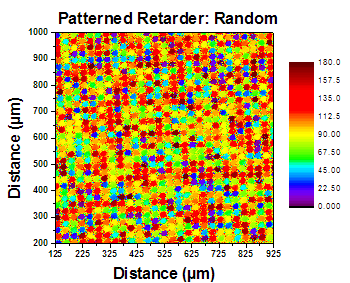
Click to Enlarge
Figure 1: Patterned Retarder with Random Distribution
Features
- Build a Custom Microretarder
- Customize Size, Shape, and Substrate Material
- Retardance Range: 50 - 550 nm
- Fast Axis Resolution: <1º
- Retardance Fluctuations Under 30 nm
Applications
- 3D Displays
- Polarization Imaging
- Diffractive Optical Applications: Polarization Gratings, Polarimetry, and Beam Steering
Thorlabs offers customizable patterned retarders, available in any pattern size from Ø100 µm to Ø2" and any substrate size from Ø5 mm to Ø2". These custom retarders are composed of an array of microretarders, each of which has a fast axis aligned to a different angle than its neighbor. The size and shape of the microretarders are also customizable. They can be as small as 30 µm and in shapes including circles and squares. This control over size and shape of the individual microretarders allows us to construct a large array of various patterned retarders to meet nearly any experimental or device need.
These patterned retarders are constructed from our liquid crystals and liquid crystal polymers. Using photo alignment technology, we can secure the fast axis of each microretarder to any angle within a resolution of <1°. Figures 1 - 3 show examples of our patterned retarders. The figures represent measured results of the patterned retarder captured on an imaging polarimeter and demonstrate that the fast axis orientation of any one individual microretarder can be controlled deterministically and separately from its neighbors.
The manufacturing process for our patterned retarders is controlled completely in house. It begins by preparing the substrate, which is typically N-BK7 or UV fused silica (although other glass substrates may be compatible as well). The substrate is then coated with a layer of photoalignment material and placed in our patterned retarder system where sections are exposed to linearly polarized light to set the fast axis of a microretarder. The area of the exposed sections depends on the desired size of the microretarder; the fast axis can be set between 0° and 180° with a resolution <1°. Once set, the liquid crystal cell is constructed by coating the device with a liquid crystal polymer and curing it with UV light.
Thorlabs' LCP depolarizers provide one example of these patterned retarders. In principle, a truly randomized pattern may be used as a depolarizer, since it scrambles the input polarization spatially. However, such a pattern will also introduce a large amount of diffraction. For our depolarizers, we designed a linearly ramping fast axis angle and retardance that can depolarize both broadband and monochromatic beams down to diameters of 0.5 mm without introducing additional diffraction. For more details, see the webpage for our LCP depolarizers.
By supplying Thorlabs with a drawing of the desired patterned retarder or an excel file of the fast axis distribution, we can construct almost any patterned retarder. For more information on creating a patterned retarder, please contact Tech Support.
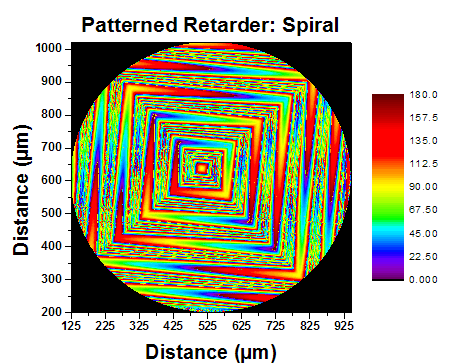
Click to Enlarge
Figure 2: Patterned Retarder with a Spiral Distribution
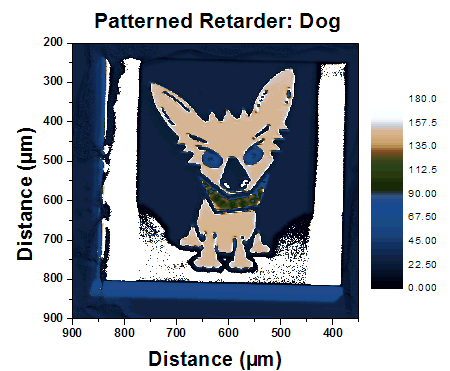
Click to Enlarge
Figure 3: Patterned Retarder with a Pictoral Distribution
| Posted Comments: | |
| No Comments Posted |

- Ø10 mm Clear Aperture
- 1" Outer Diameter
- 3 Standard AR Coatings Available
- >6λ Maximum Retardance
Thorlabs' Ø10 mm clear aperture, multi-wave liquid crystal retarders are available with AR coatings for 350 - 700 nm (LCC1115-A), 650 - 1050 nm (LCC1115-B), or 1050 - 1700 nm (LCC1115-C) light. They can provide a max retardance of >6λ. These retarders have an outer diameter of 1", making them compatible with any of our Ø1" optic mounts for 8 mm thick optics. As this retarder has a 1" outer diameter, it can be mounted using the RSP1(/M) Post-Mountable Rotation Mount or the CRM1PT(/M) 30 mm Cage Rotation Mount.

- 0 to ±25 VAC Square-Wave Output Voltage
- LCC25: 2000 ± 5 Hz
- KLC101: Adjustable from 500 Hz to 10 kHz
- Internal and External Options for Modulating the Output Square-Wave Amplitude
- Edit Settings Using Device Panel or Control via USB Input from a PC
The LCC25 and KLC101 Liquid Crystal (LC) Controllers are both designed to operate Thorlabs' liquid crystal cells, rotators, and retarders (except for the LCC2415-VIS, which has an integrated controller). Each controller supplies a a square-wave AC voltage output with an amplitude that can be adjusted from 0 VRMS to ±25 VRMS. Both will automatically detect and correct any DC offset to within ±10 mV in real time, helpful for increasing the life of liquid crystal devices.
LCC25 Benchtop Controller
The LCC25 LC Controller produces a 2000 Hz square-wave AC voltage output. Both the front panel and USB interface allow the user to select two voltage levels, Voltage 1 and Voltage 2. When the LCC25 is operated in the constant voltage mode, the output of the controller will have an amplitude equal to either of the two set voltage levels. In Modulation mode, the amplitude of the 2,000 Hz square-wave output will switch between Voltage 1 and Voltage 2 at a frequency that can be set internally (0.5 Hz to 150 Hz) or triggered externally with a 0 to 5 V TTL input (0.5 Hz to 500 Hz). The LCC25 controller's software package also allows the user to define a voltage sequence by specifying a starting voltage, ending voltage, voltage step size, and dwell time.
Please visit the LCC25 controller page for more information on this controller's features.
KLC101 K-Cube™ Controller
The KLC101 K-Cube™ LC Controller is a part of Thorlabs' growing line of high-end, compact controllers. It supplies a square-wave AC output voltage with a user-set frequency from 500 Hz to 10 kHz and features a small 60.0 mm x 60.0 mm footprint. The controller can store two voltage and frequency combinations, PresetV1 and Preset V2, either of which can be selected as the output. Additionally, the controller top panel, software, and trigger ports allow the use to create customized output voltage sequences. The voltage can be set to switch between PresetV1 and PresetV2 at rates from 0.1 and 150 Hz using the top panel controls or software. When in this mode, one of the trigger ports will output a 5 V logic signal, with the high level indicating that the output is PresetV2 and the low level indicating the output is PresetV1. Alternatively, a trigger port can be used as an input for a 5 V logic signal to switch between PresetV1 and PresetV2. The software also enables Sequence and Sweep Modes. The Sequence tool can be used to set a sequence of output voltage amplitudes, frequencies, and step durations. In Sweep mode, the KLC101 controller will scan between user-set start and end voltages with a user-specified step size and step duration.
Note that the KLC101 controller does not ship with a power supply. For applications requiring a single K-cube, the TPS002 power supply (sold below) can be used. We also offer USB controller hubs for use with multiple K-cubes.
See the full KLC101 controller web presentation for more information on the features of this controller and its power supply options.
| Item # | Adjustable Output Voltage |
Voltage Resolution |
Adjustable Output Frequencya |
Internal Modulationa |
External Modulation |
Slew Rate |
DC Offset |
Warm Up Time |
Output Current (Max) |
External Input Voltage (Max) |
|---|---|---|---|---|---|---|---|---|---|---|
| LCC25 | 0 to ±25 V RMS | 1.0 mV | 2,000 ± 5 Hz | 0.5 to 150 Hz | 0.5 to 500 Hz | 10 V/µs | ±10 mV | 30 Minutes | 15 mA | 5 VDC |
| KLC101 | 500 Hz to 10 kHz | 0.1 to 150 Hz | 150 Hz (Max) | 50 mA |
 Products Home
Products Home









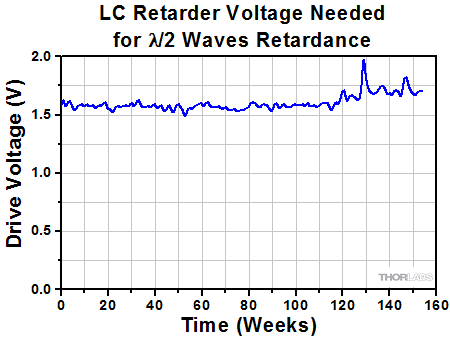
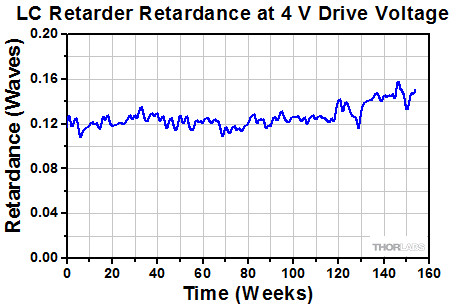

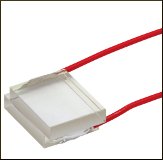
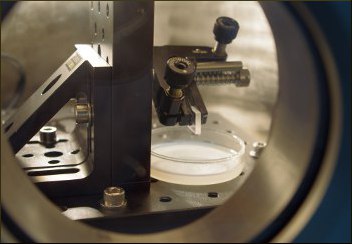


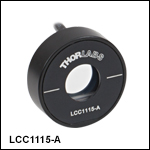
 Zoom
Zoom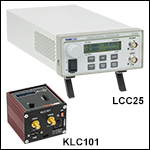
 Multi-Wave Liquid Crystal Variable Retarders
Multi-Wave Liquid Crystal Variable Retarders